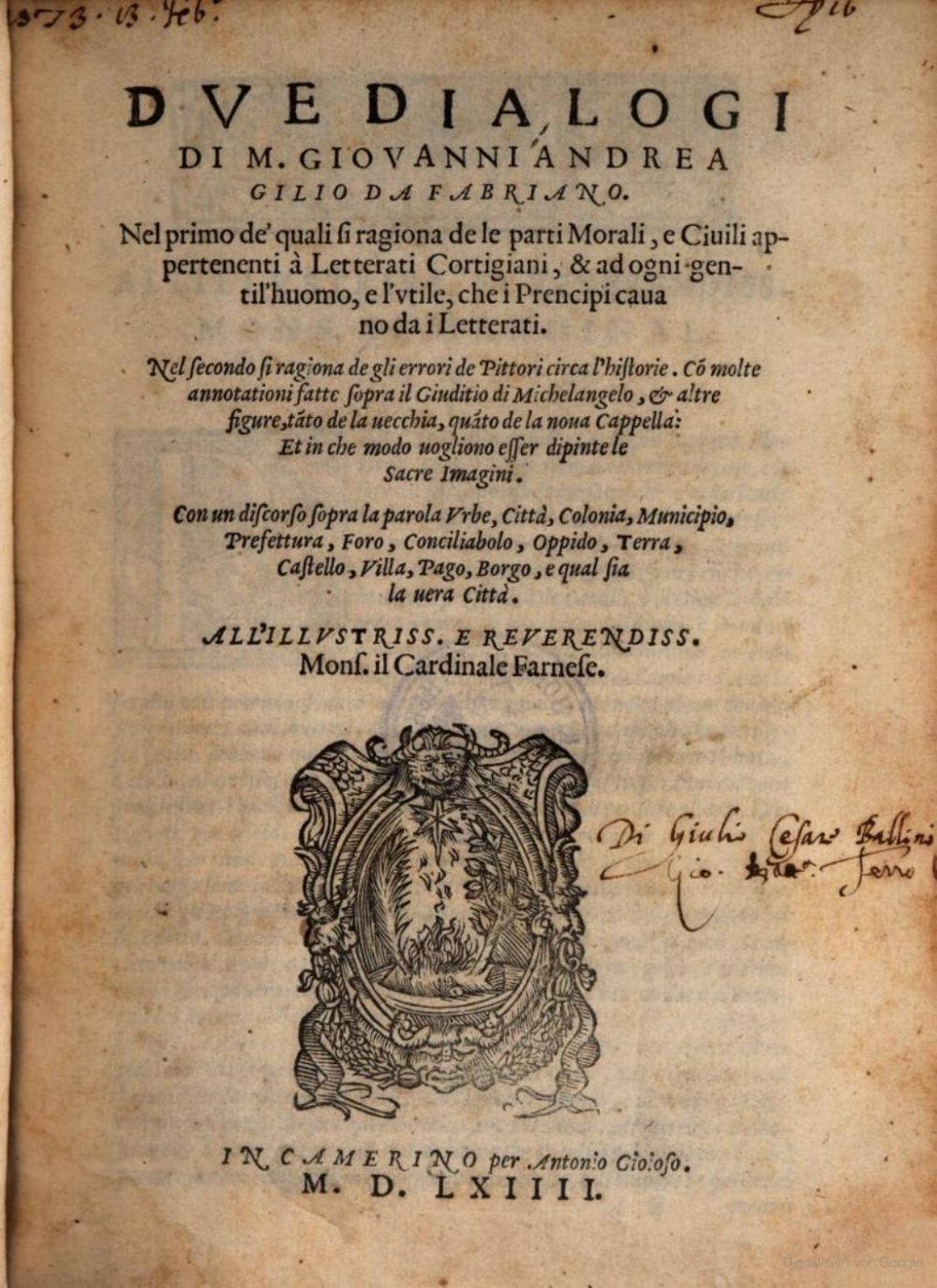
© ÖNB ABO Projekt/in Kooperation mit Google, Sig. 74.E.84 ALT PRUNK
In contrast to the poetic artist, the historical painter requires a higher level of skill. In this passage of the dialogue, the participants discuss which requirements must be met. In addition to technical skills, an artist who wants to depict such a subject must be aware of the history he is presenting. According to Pope Gregory, art should not only serve to decorate churches but also to teach the history of Christianity to the illiterate.
“‘So now’ said M. Pulidoro ‘let us discuss the historical painter a little, which requires many more details than the others. History needs much more attention than poetry because, while the latter is loose and broad, the former is fixed within limits that nobody is entitled to overstep. And I think that Eupompus spoke well when he said that arithmetic and geometry are necessary to the painter, because if he lacks knowledge of them, I don’t think he truly deserves the name of painter at all. Without them he will not know how to judge foreshortenings correctly, according to the rules, nor perspective, nor what the painting requires when seen up close, or when seen from distance. He who does not know these two subjects but who wishes to calculate the contours of the body by eye will often be deceived unless he has had great practice in long experience. So one often sees figures deformed and misshapen, without any proportion whatsoever; some that have arms, legs, or other members longer than they should, with the result that it makes one laugh to see them. Foreshortening that ought to produce an effect up close, produce it from a distance, and those that ought to produce it from a distance only produce it up close; and sometimes they produce no effect at all, or, mark commonly, of a kind different from one intended. and because this rule is observed by few, we see that mistakes are only avoided by few. I wanted to say this in order to introduce you to the subject’.
M. Silvio said: ‘It is because of this, Gentlemen, that modern painters, whether they are painting histories, fables, or mixed subjects, commit an infinite number of mistakes, and very few paintings are to be found that have the proper correspondence [debita proporzione] with their subjects. With respect to histories, few are faithful and straightforward expositors of the truth of the subject matter; and it ought to be different, for the writer and the painter – I am speaking of historical writers and painters’ are weighed on the same pair of scales. That great and learned men, Pope Gregory, said that painting is nothing other than history for the illiterate; for just as one person learns about what happened by reading a history, an illiterate person would do so by looking at a painting. Therefore, as they are both essentially equal, we will make the same judgment about each of them: the painter with his brush is no less obliged to portray the plain and simple truth than is the historian with his pen’.”
“‘Or su’, disse M. Pulidoro,’ragioniamo un poco del pittore istorico, al quale si convengono molte particolarità più che agli altri; e molta più considerazione vuole l’istoria che la poesia, perché quella è sciolta et ampia, e questa è ristretta in un termine che a niuno è lecito passarlo. E considero che ben diceva Eupompo, che al pittore si conviene l’aritmetica e la geometria: perché, se ‘l pittore si manca di queste due, non penso che rettamente nome di pittore gli si convenga, perché non saprà mai rettamente giudicare la ragione o la regola degli scurci né de la prospettiva, né quello che la pittura richieda da presso, né quello che richieda di longo. Il voler misurare le linee del corpo con l’occhio chi quelle due non sa, spesso ingannerà colui che in ciò gran pratica e lunga sperienza non ha. Però si vede spesso figure, figuraccie e figuroni senza proporzione alcuna: chi ha più del dovere lunghe le braccia o le gambe o l’altre membra, che fa ridere a vederle. Et i scurci che da presso doverebbono mostrare uno effetto, lo mostrano lontano; e quello che lontano mostrare doverebbono, lo mostrano da presso, et a le volte non lo mostrara[nno], et il più de le volte con effetti contrarii a quello che doverebbono lo mostrano. E perché questa regola è da pochi osservata, veggiamo che pochi sono che non errino. Questo ho voluto dire per introdurvi ne la materia’.
Disse M. Silvio: ‘Da questo aviene, Signori, che i moderni pittori, o dipingono istorie o favole o cose miste, commettono infiniti errori, e poche pitture si trovano ch’abbino la debita proporzione. Circa l’istorie, pochi sono fedeli e puri demostratori de la verità del soggetto, et il contrario essere doverebbe, essendo lo scrittore et il pittore in una istessa bilancia ‘de l’istorico parlo. Però diceva il gran dotto Gregorio Papa, la pittura non esser altro che l’istoria de l’ignorante: et in quel modo che uno, leggendo l’istoria, impara quello che in sé contiene, così l’ignorante, vedendo la pittura. Essendo dunque l’uno e l’altro di questi pareggiati in sé stessi, il medesimo giudizio faremo de l’uno che de l’altro, e che non sia meno ubligato a mostrare la pura e semplice verità il pittore col pennello, che si faccia l’istorico con la penna’.”
Gilio 2018, 115-116, n.86-89



